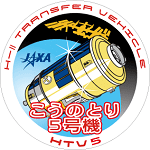Mission type ISS resupply COSPAR ID 2015-038A Spacecraft type HTV Inclination 51.65° Apogee 402,000 m | SATCAT no. 40873 Period 1.5 hours Launch date 19 August 2015 | |
 | ||
Similar | ||
Kounotori 5 htv 5 iss identified
Kounotori 5, also known as HTV-5, is the fifth flight of the H-II Transfer Vehicle, an uncrewed cargo spacecraft launched to resupply the International Space Station. It was launched on August 19, 2015.
Contents
- Kounotori 5 htv 5 iss identified
- Specifications
- Cargo
- Launch and rendezvous with the ISS
- Operation while berthed to ISS
- Departure from ISS and reentry to earth atmosphere
- References
Specifications
Major changes of Kounotori 5 from previous Kounotori are:
When approaching to ISS, previous missions were held at Approach Initiation (AI) point at 5 km behind the ISS for system checkout, but Kounotori 5 was changed to continue the approach without holding, to simplify the operation.
Cargo
Kounotori 5 was planned to carry about 5.5 tonnes cargo, consisting of 4.5 t in the pressurised compartment and 1 t in the unpressurised compartment. Due primarily to the launch failure of SpaceX CRS-7, additional 0.2 tonnes were added as the late access cargo. Total cargo weight was 6,057 kg.
Pressurised cargo include potable water (600 liter), food, crew commodities, system components, and science experiment equipments. System components include: UPA Fluids Control and Pump Assembly (FCPA), WPA Multifiltration Beds (WFB), a galley rack to be placed in Unity, and Simplified Aid For EVA Rescue (SAFER). Science experiment equipments include Mouse Habitat Unit (MHU), Electrostatic Levitation Furnace (ELF), Multi-Purpose Small Payload Rack (MSPR-2), Exposed Experiment Handrail Attachment Mechanism (ExHAM 2), NanoRacks External Platform (NREP), and CubeSats (SERPENS, S-CUBE, fourteen Flock-2b, AAUSAT5, and GOMX-3).
Unpressurised cargo consists of the Calorimetric Electron Telescope (CALET).
Originally a NASA unpressurised cargo was planned, but it was canceled.
On departure from ISS, unpressured cargo bay will carry Multi-mission Consolidated Equipment (MCE), Superconducting Submillimeter-Wave Limb-Emission Sounder (SMILES), and a NASA experiment module Space Test Program Houston 4 (STP-H4), to dispose by destructive reentry to Earth atmosphere.
Launch and rendezvous with the ISS
It was originally planned for launch in 2014 but was later postponed due to delay in the construction and qualification testing of payload to fly on the capsule.
In June 2015, it was scheduled to be launched at around 13:01 UTC on August 16, 2015.
Due to the bad weather forecast, on August 14 the launch was postponed to August 17, and then on August 16 it was postponed again to August 19.
Kounotori 5 was successfully launched with a H-IIB carrier rocket flying from pad 2 of the Yoshinobu Launch Complex at Tanegashima at 11:50:49 UTC on 19 August 2015. Communication and three-axis attitude controls were established shortly after the launch. Phase Maneuver was performed by 19:25 UTC on August 20, and the first Height Adjustment Maneuver by 17:55 UTC on August 22. The second and third Height Adjustment Maneuver were performed by 03:07 and 06:12 UTC on August 24, respectively.
The ISS's robotic arm SSRMS grappled Kounotori 5 at 10:29 UTC on 24 Aug 2015, and fastened to ISS's CBM at 14:58 UTC on 24 Aug 2015. All berthing operations were completed at 17:28 UTC on 24 Aug 2015.
Operation while berthed to ISS
From 02:27 UTC on August 25, the Exposed Pallet (EP), which is carrying CALET, was extracted from Kounotori 5's Unpressurized Logistics Carrier (ULC) by the ground-controlled SSRMS, and handed off to the Japanese Experiment Module Remote Manipulator System (JEMRMS), which is also remote-controlled from ground. The JEMRMS then attached the palette to the JEM Exposed Facility (EF). Later, at 14:29 UTC on the same day, CALET was removed from the palette and installed to the Exposed Facility by the JEMRMS.
The ISS crew opened the hatch of the Kounotori's Common Berthing Mechanism and entered to Pressurized Logistics Carrier at 10:24 UTC on 25 Aug 2015 and began transferring the cargo.
Departure from ISS and reentry to earth atmosphere
Kounotori 5 was unberthed from the CBM at 11:12, 28 September 2015 UTC by SSRMS robotic arm and moved to the release position. The first attempt of the release at 15:20 UTC was aborted due to an anomaly of the SSRMS. After one ISS orbit, Kounotori 5 was released from the SSRMS at 16:53, 28 September 2015 UTC, Expedition 45 Flight Engineer Kimiya Yui of JAXA, backed up by NASA Flight Engineer Kjell Lindgren, commanded the SSRMS.
After the orbit control maneuvers, Kounotori 5 reentered to the Earth atmosphere over the southern Pacific Ocean around 20:33, 29 September 2015 UTC.
